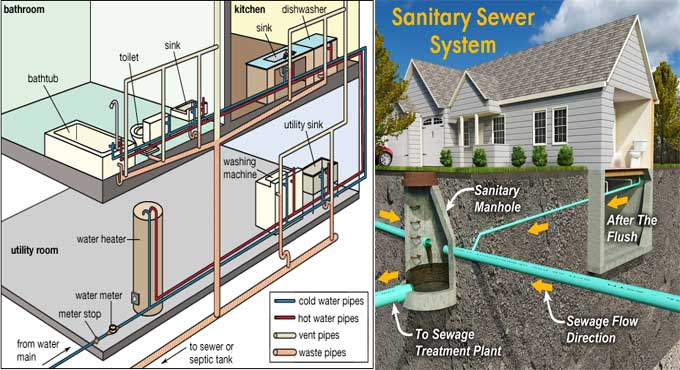
The Fundamentals of Plumbing Systems: Drainage and Supply Subsystems

In the realm of construction and civil engineering, the efficient management of water is a cornerstone of functionality and safety. A well-designed plumbing system ensures the proper supply of clean water and the effective removal of wastewater from structures. This intricate network of pipes, fixtures, and components forms the backbone of modern infrastructure.
In this comprehensive article, we will delve into the fundamental aspects of plumbing systems, focusing on drainage and supply subsystems. We'll explore their significance, uses in construction, advantages, disadvantages, related factors, and their integration with other critical systems.
Understanding Basic Plumbing Systems
At the heart of a functional building lies a well-designed plumbing system that encompasses two primary subsystems: the drainage system and the supply system.
These subsystems work seamlessly together to provide clean water for consumption, sanitation, and other purposes, while efficiently removing wastewater to prevent health hazards and environmental contamination.
Drainage System
The drainage system is a crucial aspect of any plumbing setup, responsible for the efficient removal of wastewater from within a structure. This system consists of an intricate network of pipes, traps, vents, and fixtures designed to carry away used water from sinks, toilets, showers, and other sources.
Supply System
On the other hand, the supply system ensures the consistent delivery of clean and potable water to various fixtures within a structure. This subsystem encompasses an array of pipes, pumps, valves, and other components working in harmony to maintain a steady flow of safe drinking water.
Uses in Construction
Plumbing systems are essential components of construction, serving a myriad of vital purposes:
1. Sanitation and Health
An impeccable plumbing system is critical for maintaining sanitation and public health. By effectively removing wastewater, it prevents the spread of disease and contamination.
2. Clean Water Supply
The supply subsystem is at the core of providing clean and potable water, enabling daily activities such as drinking, cooking, and personal hygiene.
3. Building Comfort
Modern plumbing systems elevate living comfort by offering convenient access to hot and cold water for showers, baths, and cleaning.
4. Waste Removal
The drainage subsystem efficiently disposes of wastewater, preventing the accumulation of stagnant water that could breed bacteria and cause foul odours.
Advantages of Plumbing Systems
Plumbing systems offer numerous advantages that significantly contribute to the quality of life and safety:
1. Disease Prevention
Efficient wastewater removal prevents the accumulation of hazardous materials, significantly reducing the risk of disease transmission.
2. Convenience
Plumbing systems provide convenient access to water for various purposes, promoting comfortable and hygienic living conditions.
3. Environmental Protection
By ensuring the proper drainage of wastewater, plumbing systems prevent pollution and help safeguard the environment.
4. Safety
Well-designed plumbing systems minimize the risk of waterborne illnesses and protect residents from potential health hazards.
Disadvantages of Plumbing Systems
While plumbing systems bring undeniable benefits, they also come with certain limitations:
1. Complexity
Plumbing systems are inherently complex and require careful design, precise installation, and regular maintenance to function effectively.
2. Maintenance
Regular maintenance is essential to prevent leaks, blockages, and other issues that can disrupt the system's functionality.
3. Cost
Both the initial installation and ongoing maintenance of plumbing systems can be financially demanding, requiring a significant investment.
4. Water Conservation
Inefficiently managed plumbing systems can contribute to water wastage, impacting both the environment and utility bills.
Factors to Consider in Plumbing Systems
Several factors significantly influence the design and functionality of plumbing systems:
1. Building Type and Size
The size and purpose of the structure dictate the complexity and specific requirements of the plumbing system.
2. Water Source
The availability and quality of the water source influence the treatment and purification processes necessary for maintaining a clean water supply.
3. Local Regulations
Adhering to building codes and regulations is crucial to ensure that the plumbing system design complies with safety and environmental standards.
4. Climate Considerations
Climate plays a pivotal role in determining insulation requirements and protection of pipes to prevent freezing and potential damage.
Integration with Other Systems
Plumbing systems seamlessly interface with various other critical systems within a structure:
1. Electrical System
Plumbing systems and electrical systems often intersect in components like water heaters and pumps, where both systems work together to provide efficient functionality.
To learn more, watch the following video tutorial.
Video Source: Ekeeda
2. HVAC System
The effectiveness of heating, ventilation, and air conditioning systems is closely tied to plumbing, particularly in systems such as radiant heating.
3. Structural Design
Plumbing systems have a substantial impact on the structural design of a building, influencing the arrangement of pipes, fixtures, and necessary support mechanisms.
Final Thoughts
Plumbing systems stand as the unsung heroes of modern construction, ensuring the availability of clean water and the efficient removal of wastewater. The drainage and supply subsystems collaborate harmoniously to provide sanitation, comfort, and health while adhering to stringent safety and environmental standards.
While they offer numerous advantages, including disease prevention and convenience, they also present challenges such as complexity and maintenance demands. By carefully considering factors such as building type, local regulations, and climate, engineers can design effective plumbing systems that seamlessly integrate with other vital components of a structure. In the ever-evolving landscape of construction and technology, plumbing systems continue to play a pivotal role in shaping our built environment for the better.


